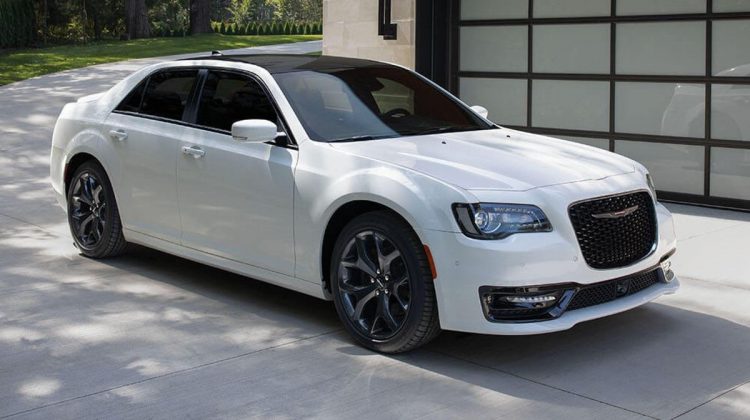2021 Chrysler 300 Review, Pricing and Specs
Overview
Large sedans are quickly disappearing from dealership showrooms, but the 2021 Chrysler 300 is one big four-door that continues to solider on. It harkens back to a time when large American sedans powered by big-displacement engines ruled the road. And when you put it next to its more modern rivals, you can really start to see its age. Buyers can choose from either a V-6 or a V-8 engine, the latter of which is mighty powerful but guzzles fuel like a truck. Inside, the 300 offers a spacious cabin for four adults. Alternatively, the wide bench seat in back will easily accommodate three kids. Although it would be a stretch to call it a sports sedan, the 300 delivers a few driving thrills and, unless you go with the sportier 300S, a controlled and easy ride.
What’s New for 2021?
Chrysler has discontinued the upscale Limited and 300C trims for 2021, leaving just the Touring, Touring L, and 300S models. The Touring L and 300S both receive some new standard equipment, such as front and rear parking sensors, blind-spot monitoring, and rear-cross-traffic alert. Chrysler also made the Red S Appearance package standard on the 300S this year. It includes gloss-black exterior trim, unique 20-inch wheels, and special badging. A Comfort Group package is now available on the top two trims and brings leather upholstery, ventilated front seats, heated rear seats, a power tilt-and-telescoping steering column, and more convenience features. The Popular Equipment package adds in-dash navigation, SiriusXM satellite radio, and a nine-speaker stereo with a subwoofer.
Pricing and Which One to Buy
We’d recommend the mid-range Touring L model, which bundles plenty of luxury and convenience features at a reasonable price. It comes with the standard 3.6-liter V-6 and can be had with rear- or all-wheel drive. We’d also spring for the aforementioned Comfort Group pack because we think large sedans should provide a certain level of plushness. If you want the V-8, you’ll have to upgrade to the more expensive 300S, which adds a stiffer suspension and, thus, a rougher ride. Shoppers should also take note of the V-8’s thirst for fuel.
Engine, Transmission, and Performance
In the large-car segment, the Chrysler 300 is unusual for its rear-wheel-drive layout and its available Hemi V-8 engine with 363 horsepower. All-wheel drive is optional but only with the standard 292-hp 3.6-liter V-6 engine. In our testing, a rear-wheel-drive V-6-powered 300S hustled to 60 mph in 6.3 seconds; that’s slow for this class but still reasonably sprightly. A V-8-powered rear-driver netted a snappy 5.3-seconds result in the same test back in 2015. The 300 is not a bad-handling car for its size. The helm isn’t the most talkative, but body roll is well controlled, and the chassis is willing to play—as long as you don’t get overly aggressive. The stiffer suspension and 20-inch wheels on the 300S make that particular model ride a bit rough, which seems out of step with the 300’s near luxury mission. If you’re in the market for something comfy, stick to the Touring or Touring L.
Fuel Economy and Real-World MPG
With the 3.6-liter V-6 under its hood, the 300 falls just a bit short of its rivals when it comes to fuel economy. Other competitors—such as the Nissan Maxima—are simply more efficient. The 300 did match its EPA combined estimate of 30 mpg in our real-world testing, but the Toyota Avalon fared much better, besting the Chrysler by 4 mpg. Order up the Hemi 5.7-liter V-8 and this four-door is quite the gas consumer, averaging 19 mpg combined per the EPA’s yardstick.
Interior, Comfort, and Cargo
The 300’s entry-level offering is the Touring. It comes with cloth seats and few amenities. The fancier Touring L and 300S models boast far more features, including power-adjustable front seats with heat and adjustable lumbar support, dual-zone automatic climate control, a leather-wrapped steering wheel, leather seats, and illuminated front and rear cupholders. Heated and ventilated front seats, heated rear seats, a heated steering wheel, and a power-adjustable steering wheel are optional on all but the base model. Chrysler utilizes soft-touch rubberized plastic with a leather-grain pattern to cover the dashboard and upper door panels of every 300. The texture feels nice but looks artificial. The interior design is aging, and not gracefully. The Kia Cadenza simply outclasses the 300 in this area. The 300, like just about every car in this segment, manages to fit six carry-on boxes inside the trunk. With the rear seats folded, it swallowed another 10. Those seats can be split in a 60/40 arrangement, but they don’t fold completely flat.
Infotainment and Connectivity
We appreciate Chrysler’s Uconnect infotainment system for its ease of use, intuitive menu layout, and snappy performance. The 300’s standard 8.4-inch touchscreen display will also show the Apple CarPlay and Android Auto interfaces. SiriusXM satellite radio is also offered with a one-year trial period, and in-dash navigation is optional.
Safety and Driver-Assistance Features
Spotty performance in the 300’s crash testing is a cause for concern. Chrysler’s driver-assistance gear, bundled in the SafetyTec Plus package, is available for all but the base model. Key safety features include:
- Available automated emergency braking
- Available adaptive cruise control
- Available lane-keeping assist
Warranty and Maintenance Coverage
Chrysler’s warranty coverage for the 300 is nothing special. Some rivals offer similar packages, but the standout winner here is the Kia Cadenza, with up to 10 years or 100,000 miles of coverage.
- Limited warranty covers three years or 36,000 miles
- Powertrain warranty covers five years or 60,000 miles
- No complimentary scheduled maintenance


